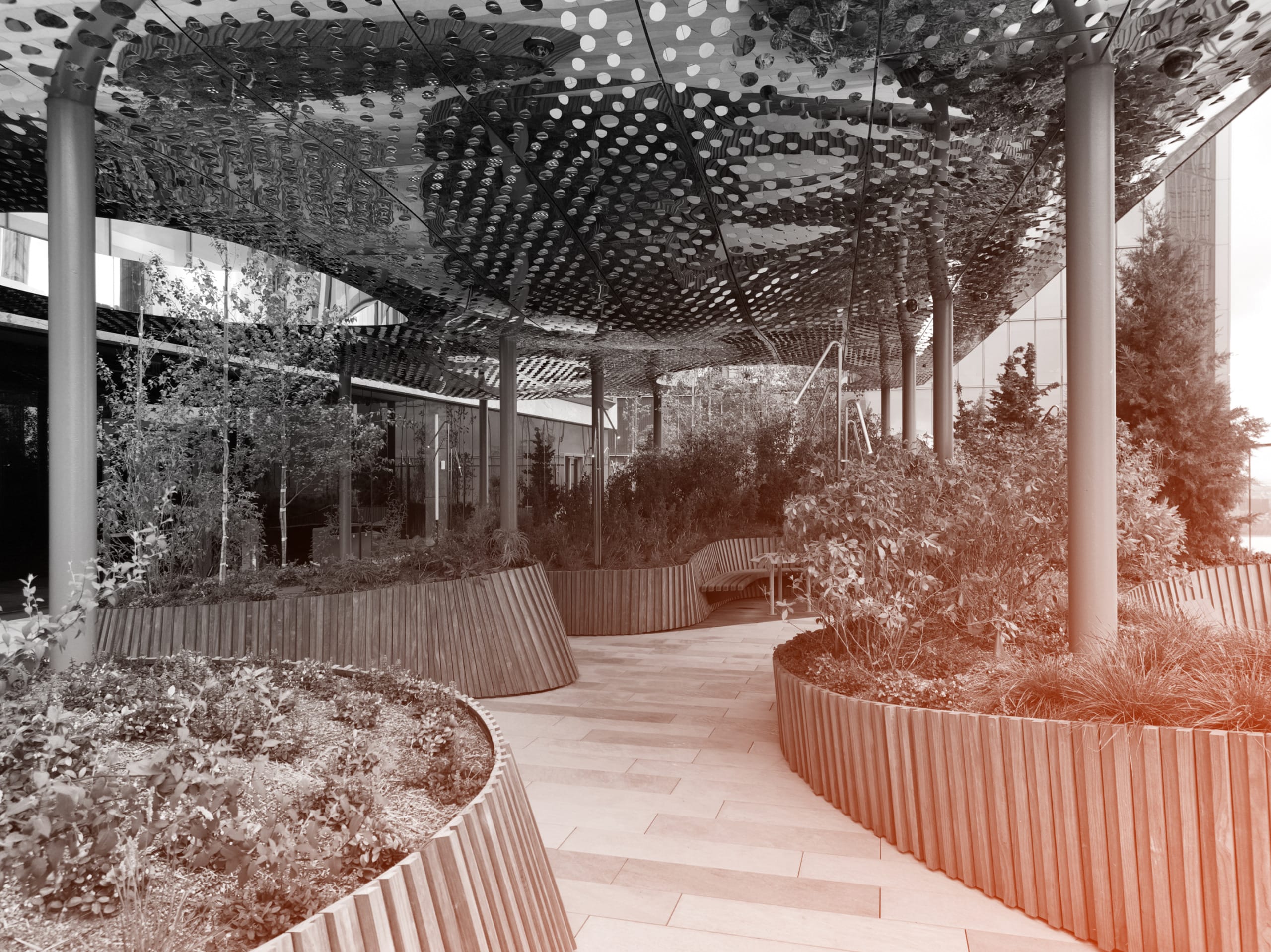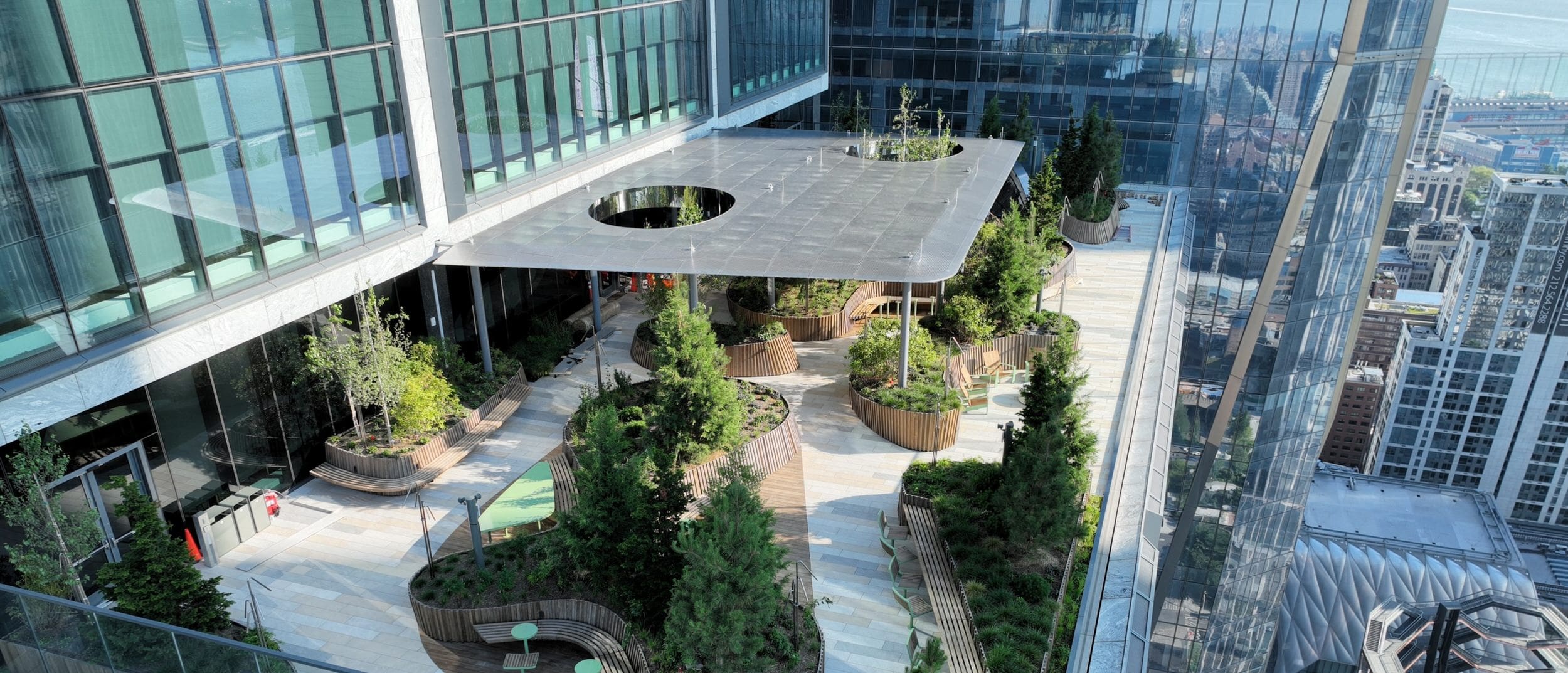The Role of Architectural Metals in Building Healthier & More Engaging K-12 Environments
An exploration of how architectural metal can be used in school entrances, outdoor spaces, and circulation spaces.
Educational facilities for the K-12 years—a time when students are going through physical, intellectual, and emotional changes—require thoughtful planning and design. These learning environments should provide a healthy and natural transition between the insulated world of elementary school and the formative years of high school and beyond that inspire both academic and social exploration.
Here we take a closer look at how architectural metals are being used in the design of K-12 schools to promote healthy engagement and learning to set students up for lifelong success.
K-12 schools are more than just a collection of buildings and classrooms. They offer students much more than an education.
Schools are places where friendships and community begin. They provide shelter, warmth, and food. They teach practical, as well as emotional lessons that last a lifetime.
Ideally, they also spark enthusiasm, engagement, and a thirst for knowledge. Research shows that when children and adolescents are more engaged and enthused about their own learning they are more likely to achieve at higher levels.
A portrait of Carver Elementary's namesake, fabricated from Angel Hair® Stainless Steel and featuring Zahner’s Cross-Seam Perf™ technology, overlooks the school's playground.
PHOTO BY SARAH TESFAI, ARKO | © A. ZAHNER COMPANYMeeting the Requirements of Today’s Learning Environments
Geometry and space planning for schools take up most of the concepting and design time for good reason: school buildings must first and foremost facilitate the mass movements and meetings of hundreds, and often thousands, of students and teachers that work together in these buildings every day.
The most engaging learning environments often use design and architectural elements that start at the front door—and sometimes even before that—in the outdoor spaces and courtyards that surround a school. Thoughtful architecture and design elements must then continue throughout the classrooms, hallways, cafeterias, and libraries to make school buildings as inviting, safe, and healthy as they can be.
Materials play an important role as well. The materials being used in these new designs are shattering the conventions of poured concrete, block walls, and framed windows. More and more, schools are turning to architectural metals, patterns, finishes, and patinas. When used smartly metals can add value, functionality, and beauty.
Let’s take a look at a few functional areas and the design considerations for these spaces—and how architectural metals could play a role making them healthier and more inviting.
Blue Valley High School's mascot greets students and faculty alike as the enter the building.
K-12 School Entrances: Where Safety, Motivation and School Pride Begin
According to Healthy Schools by Design, a comprehensive resource for thoughtful and healthy educational design created by Perkins&Will, approximately 25% of Americans enter a school building everyday—as teachers, students, staff, or administrators. The entryway of a school building can have short-term and long-term exposures that have both social and physical implications.
School entrance design is more important than ever when considering the best ways to foster positive and productive communications among students, families, and teachers.
For example, an entrance filled with natural light stimulates the senses, suppresses sleep-inducing melatonin levels, and supports better comprehension. Children, with their larger pupils, are more sensitive to light and its energizing properties. In particular, blue light from the sun makes students more naturally alert.
A well-designed entrance can also feature design elements that impact students and teachers in emotional and psychological ways by helping to:
- Tell a story
- Boost self-esteem
- Create a sense of belonging, engagement, and ownership
The variety of colors and textures, as well as their sustainability, make architectural metals affordable and attractive additions to school entrances.
Painted aluminum offers bright, bold colors to make spaces feel fun and alive.
PHOTO BY CURTIS SMITH | ARKOPatinated copper, like Zahner's Dirty Penny, provides beautiful earth tones.
PHOTO © A. ZAHNER COMPANY.Stainless steel offers incredible versatility and timeless aesthetic appeal.
PHOTO BY PARKER ANDERSON, ARKO | © A. ZAHNER COMPANYArchitectural metals offer versatility and design flexibility for school entrances and can be customized in numerous ways with:
- Textures, colors, finishes, and patinas that match school colors or geography
- Perforated imagery that display words, pictures, symbols, or art
- Punch pressing, engraving, folding, and water jetting for other unique designs
The symbols and signs that people see when entering a school also contribute to their perception of the facility’s quality. This can have a positive impact on student and teacher attraction and retention, since the entrance provides a first impression of the level of commitment and resources available to support students and teachers.
A perforated metal screen wall creates a private space for the courtyard at Washington Elementary.
Photo by Tex Jernigan © A. Zahner Company 2016The decorative screen walls also provide security to the school entrance and courtyard.
Photo by Tex Jernigan © A. Zahner Company 2016Perforated screen walls within the courtyard further define spaces for movement and rest, while also providing another opportunity to emphasize school spirit.
Photo by Tex Jernigan © A. Zahner Company 2016K-12 Outdoor Environments: The Benefits of Combining Nature and Learning
Outdoor environments in K-12 educational settings contribute greatly to the overall wellbeing of students and teachers alike. While the pandemic has taught us much about adaptation, resilience, and the importance of wide open spaces, separate research studies before the health crisis have also proven that students with greater access to outdoor spaces had better mental health, higher test scores, and lower chronic absenteeism (Kweon et al., 2017; MacNaughton et al., 2017).
Research has shown that time in the outdoors lowers stress levels, improves attention spans, and creates a more lasting sense of joy (Kuo et al., 2019).
Trees, bushes, flowers, and blue sky are the most important and inspiring elements of outdoor spaces. However, fencing, gates, screens, and sunshades can add to the attraction as well. The end result, when properly balanced, is enhanced safety, health, and engagement.
Perforated metal screens, gates, and fences create a more aesthetically-pleasing experience for those inside their defined space. They can also be very effective in blocking unwanted noise and visual pollutants from the outside—such as highways, parking lots, and industrial areas.
A nighttime view of Pembroke Hill preparatory school's barrel-vaulted dining hall, which features artwork by Dutch artist Jan Hendrix, fabricated by Zahner.
PHOTO © A. ZAHNER COMPANY.A daytime view of the opposite side of the dining hall.
PHOTO © A. ZAHNER COMPANY.A close-up view of the intricate detail in Hendrix's design, rendered in stainless steel.
PHOTO © A. ZAHNER COMPANY.Circulation Spaces: Hallways and Stairwells Connect It All Together
Just as entrances and outdoor spaces present opportunities for boosting emotional well-being, so too do the corridors, stairways, and elevators in school buildings that are used by everyone, every day.
When circulation spaces are integrated with the entire design aesthetic, they reinforce:
- School values
- Sense of community
- Teamwork
- Clearer wayfinding throughout the school
Research shows that people-place cues and social wayfinding can improve psychological safety. Bright accents and warm hues become visual cues that lower stress levels and foster good navigation skills.
The durability and flexibility of architectural metals make them a natural choice for these public spaces as well. Images of historical figures, motivational quotes, and subtle reminders of core values—all etched or punched in metal—give a sense of gravitas and permanence.
Designing for Engagement and Learning
In their formative K-12 years, children and adolescents are like sponges absorbing all that they encounter, especially in school buildings where they are likely to spend nearly 12,000 hours over the course of 12 years of primary and secondary education.
A student’s learning environment matters greatly. And every design element counts when it comes to creating a safe, healthy, and engaging learning environment.
The right blend of architectural metals can help by creating inspiring entryways, outdoor sanctuaries, and more functional and beautiful hallways that promote community and pride at every turn.
Custom screen walls emphasize a sports theme for Okie Blanchard Sports Complex while also functioning as passive security measures that prevent access under the bleachers.
PHOTO © A. ZAHNER COMPANY.To find out more about using using architectural metals, and perforated or patterned metals, in your next K-12 project contact us or call +1 (816) 474-8882 to speak with one of our Project Specialists.
References
- Kweon, B.-S., et al. (2017). “The link between school environments and student academic performance.” Urban Forestry & Urban Greening 23: 35-43
- MacNaughton P, Eitland E, Kloog I, Schwartz J, Allen J. Impact of Particulate Matter Exposure and Surrounding “Greenness” on Chronic Absenteeism in Massachusetts Public Schools. Int J Environ Res Public Health. 2017 Feb 20;14(2):207. doi: 10.3390/ijerph14020207. PMID: 28230752; PMCID: PMC5334761.
- Kuo, M., Barnes, M., & Jordan, C. (2019). Do Experiences With Nature Promote Learning? Converging Evidence of a Cause-and-Effect Relationship. Frontiers in psychology, 10, 305. https://doi.org/10.3389/fpsyg.2019.00305

















 PHOTO © Tim Hursley
PHOTO © Tim Hursley









 PHOTO ©️ Parrish Ruiz de Velasco (parrch.com)
PHOTO ©️ Parrish Ruiz de Velasco (parrch.com)



 © Fedora Hat Photography
© Fedora Hat Photography Photo by Andre Sigur | ARKO
Photo by Andre Sigur | ARKO





 Ɱ, Creative Commons Attribution-Share Alike 4.0 International license, edited.
Ɱ, Creative Commons Attribution-Share Alike 4.0 International license, edited.


